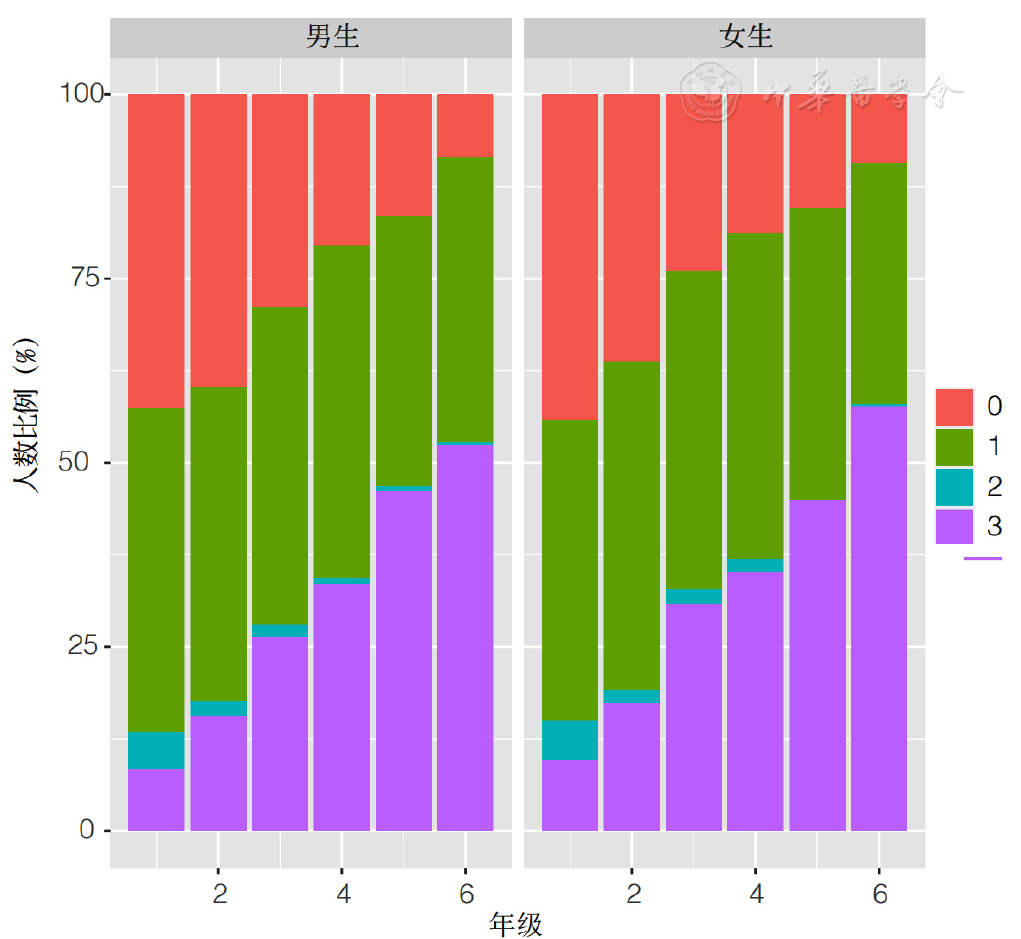

Chinese General Practice ›› 2022, Vol. 25 ›› Issue (30): 3817-3824.DOI: 10.12114/j.issn.1007-9572.2022.0250
Special Issue: 社区卫生服务最新研究合辑; 儿科最新文章合辑
• Article·Focus on Special Population·Adolescents • Previous Articles Next Articles
Received:2022-04-10
Revised:2022-06-24
Published:2022-10-20
Online:2022-07-14
Contact:
Ningli WANG
About author:
通讯作者:
王宁利
作者简介:
Add to citation manager EndNote|Ris|BibTeX
URL: https://www.chinagp.net/EN/10.12114/j.issn.1007-9572.2022.0250
| 年级 | 学生(n=5 558) | 男生(n=2 907) | 女生(n= 2 651) |
|---|---|---|---|
| 1年级 | 4.93±0.14 | 4.94±0.14 | 4.93±0.14 |
| 2年级 | 4.93±0.21 | 4.93±0.20 | 4.93±0.21 |
| 3年级 | 4.86±0.27ab | 4.87±0.27 | 4.86±0.26 |
| 4年级 | 4.84±0.28ab | 4.86±0.28 | 4.83±0.30 |
| 5年级 | 4.78±0.32abc | 4.79±0.31 | 4.77±0.34 |
| 6年级 | 4.70±0.35abcd | 4.72±0.35 | 4.68±0.36 |
| F值 | 100.413 | 47.168 | 53.042 |
| P值 | <0.001 | <0.001 | <0.001 |
Table 1 Comparison of uncorrected distance visual acuity among students,male and female students in grades 1-6
| 年级 | 学生(n=5 558) | 男生(n=2 907) | 女生(n= 2 651) |
|---|---|---|---|
| 1年级 | 4.93±0.14 | 4.94±0.14 | 4.93±0.14 |
| 2年级 | 4.93±0.21 | 4.93±0.20 | 4.93±0.21 |
| 3年级 | 4.86±0.27ab | 4.87±0.27 | 4.86±0.26 |
| 4年级 | 4.84±0.28ab | 4.86±0.28 | 4.83±0.30 |
| 5年级 | 4.78±0.32abc | 4.79±0.31 | 4.77±0.34 |
| 6年级 | 4.70±0.35abcd | 4.72±0.35 | 4.68±0.36 |
| F值 | 100.413 | 47.168 | 53.042 |
| P值 | <0.001 | <0.001 | <0.001 |

Figure 2 Comparison of warning levels for myopia risk assessed based on the uncorrected distance visual acuity between male and female students in grades 1-6
| 年级 | 学生(n=5 558) | 男生(n=2 907) | 女生(n=2 651) |
|---|---|---|---|
| 1年级 | -0.16±0.91 | -0.18±0.90 | -0.13±0.92 |
| 2年级 | -0.34±0.98a | -0.31±1.00 | -0.37±0.97 |
| 3年级 | -0.78±1.27ab | -0.73±1.29 | -0.83±1.25 |
| 4年级 | -1.02±1.38abc | -1.02±1.41 | -1.00±1.35 |
| 5年级 | -1.50±1.78abc | -1.53±1.81 | -1.47±1.75 |
| 6年级 | -2.10±1.97abcd | -2.05±1.94 | -2.16±2.00 |
| F值 | 474.728 | 121.704 | 123.807 |
| P值 | <0.001 | <0.001 | <0.001 |
Table 2 Comparison of spherical equivalent among in male and female students in grades 1-6
| 年级 | 学生(n=5 558) | 男生(n=2 907) | 女生(n=2 651) |
|---|---|---|---|
| 1年级 | -0.16±0.91 | -0.18±0.90 | -0.13±0.92 |
| 2年级 | -0.34±0.98a | -0.31±1.00 | -0.37±0.97 |
| 3年级 | -0.78±1.27ab | -0.73±1.29 | -0.83±1.25 |
| 4年级 | -1.02±1.38abc | -1.02±1.41 | -1.00±1.35 |
| 5年级 | -1.50±1.78abc | -1.53±1.81 | -1.47±1.75 |
| 6年级 | -2.10±1.97abcd | -2.05±1.94 | -2.16±2.00 |
| F值 | 474.728 | 121.704 | 123.807 |
| P值 | <0.001 | <0.001 | <0.001 |
| 时间 | 学生(n=2 640) | 男生(n=1 445) | 女生(n=1 195) |
|---|---|---|---|
| 第1次:2019年9月 | 4.91±0.20 | 4.89±0.22 | 4.93±0.18 |
| 第2次:2020年9月 | 4.89±0.25 | 4.89±0.26 | 4.90±0.24 |
| 第3次:2021年3月 | 4.85±0.29ab | 4.85±0.29 | 4.85±0.31 |
| 第4次:2021年9月 | 4.85±0.31ab | 4.88±0.28 | 4.81±0.34 |
| F值 | 8.727 | 2.153 | 10.221 |
| P值 | 0.021 | 0.0917 | <0.001 |
Table 3 Comparison of uncorrected distance visual acuity in all students,male and female students at different times
| 时间 | 学生(n=2 640) | 男生(n=1 445) | 女生(n=1 195) |
|---|---|---|---|
| 第1次:2019年9月 | 4.91±0.20 | 4.89±0.22 | 4.93±0.18 |
| 第2次:2020年9月 | 4.89±0.25 | 4.89±0.26 | 4.90±0.24 |
| 第3次:2021年3月 | 4.85±0.29ab | 4.85±0.29 | 4.85±0.31 |
| 第4次:2021年9月 | 4.85±0.31ab | 4.88±0.28 | 4.81±0.34 |
| F值 | 8.727 | 2.153 | 10.221 |
| P值 | 0.021 | 0.0917 | <0.001 |
| [1] |
|
| [2] |
|
| [3] |
|
| [4] |
王宁利,李仕明,魏士飞. 我国儿童青少年近视眼防控工作中的重点和难点[J]. 中华眼科杂志,2021,57(4):241-244. DOI:10.3760/cma.j.cn112142-20210123-00047.
|
| [5] |
新华网. 习近平:共同呵护好学生的眼睛 让他们拥有一个光明的未来[EB/OL]. (2018-8-28)[2021-11-11].
|
| [6] |
教育部,国家卫生健康委员会,国家体育总局,等. 综合防控儿童青少年近视实施方案[EB/OL]. (2018-08-30)[2021-08-11].
|
| [7] |
国家卫生健康委员会. 国卫通〔2020〕1号《中小学生屈光不正筛查规范》[EB/OL]. (2020-01-11)[2021-08-11].
|
| [8] |
央视网. 卫健委:全国儿童青少年近视率53.6%高中生高达81%[EB/OL]. (2019-04-29)[2021-08-11].
|
| [9] | |
| [10] |
|
| [11] |
邹海东,何鲜桂,马莹琰,等. 依据《中小学生屈光不正筛查规范》开展青少年屈光不正防控工作[J]. 中华实验眼科杂志,2020,38(6):473-475. DOI:10.3760/cma.j.cn115989-20200113-00024.
|
| [12] |
王玉林,徐奇,胡蝶,等. 上海市城乡结合地区中小学生视力及屈光现况[J]. 中华全科医学,2021,19(8):1336-1338,1342. DOI:10.16766/j.cnki.issn.1674-4152.002054.
|
| [13] |
苏哲,肖林,刘鹏飞. 小瞳孔电脑验光在儿童屈光不正筛查中的可行性探讨[J]. 国际眼科杂志,2015,15(7):1287-1289.
|
| [14] |
|
| [15] |
|
| [16] |
|
| [17] |
|
| [18] |
李霞,高晓唯,雷英. 青少年近视与右利手关系的临床观察[J]. 国际眼科杂志,2009,9(10):2011-2012. DOI:10.3969/j.issn.1672-5123.2009.10.060.
|
| [19] |
熊佳伟,周行涛,莫晓芬. 儿童屈光参差临床研究进展[J]. 中国眼耳鼻喉科杂志,2017,17(4):288-291. DOI:10.14166/j.issn.1671-2420.2017.04.017.
|
| [20] |
李丹,赵桁,李杰,等. 低度近视性屈光参差儿童主导眼调节参数研究[J]. 临床眼科杂志,2021,29(1):50-53. DOI:10.3969/j.issn.1006-8422.2021.01.012.
|
| [21] |
|
| [22] |
搜狐网. 教育部长陈宝生:打好儿童青少年近视防控这场攻坚战持久战[EB/OL]. (2018-09-08)[2021-08-11].
|
| [23] |
人民网. 习近平谈青少年健康:要文明其精神,野蛮其体魄[EB/OL]. (2020-04-22)[2021-08-11].
|
| [24] |
|
| [25] |
|
| [26] |
|
| [27] |
李翯,李仕明,刘洛如,等. 河南安阳初中学生眼屈光度及生物学参数分布[J]. 中华医学杂志,2014,94(17):1284-1288. DOI:10.3760/cma.j.issn.0376-2491.2014.17.002.
|
| Viewed | ||||||
|
Full text |
|
|||||
|
Abstract |
|
|||||